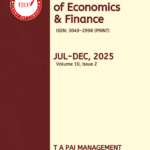-Hradayesh Kumar Pathak | Neeraj Nayan

Introduction
In this essay, we are mainly going to emphasize how the appreciation of the US Dollar i.e., USD against other currencies would impact different sectors of an economy in the context of India. The growth trajectory of the Indian Economy post the Liberalization, Privatization, and Globalization (LPG) reforms has been stupendous. The CAGR of close to 7% for almost 25 years is extraordinary for any economy and India has been able to sustain this growth for such a long period. This growth was coincidental with the growth of the world economy.
However, the Indian economy has undergone some exceptional phases of macroeconomic developments and growth pattern post the Global Financial Crisis. When the world economy was growing at a very tepid pace, the Indian economy was an exception, growing at nearly 8% compounded annual growth and then Demonetization struck the Indian Economy and Goods and Services Tax (GST) was rolled out without proper planning of its implementation. The growth trajectory took a hit for some time and it’s only recently that India’s growth seems to be picking up once again (the last quarter’s GDP growth has reached close to 8.5 %).
For the liberalized economy that India is, it is a given that when the world economy, and especially the USA, is growing at an unprecedented growth level of close to 4 %, there is a huge opportunity for India to maintain sustainable double-digit growth. Former RBI Governor, Mr. Raghuram G Rajan, has pointed out that had there been a proper implementation of Demonetization and Goods and Services Tax (GST), India could have easily achieved a sustainable annual growth rate of 10% or more. Indian economy has been built on some very strong fundamentals, thanks to prudent RBI measures and is expected to grow at more than 8% for a long period of time. The recent developments across the world have however impacted the current macroeconomic situations in India. The protectionist measures adopted by the US president, Mr. Donald Trump, the rising crude oil prices mainly because of sanctions imposed against Iran, and the appreciation in Dollar value has adversely affected many sectors of India.
The trade war between two of the biggest economies, the USA and China is bound to have its repercussions across all the economies of the world. The protectionist measures adopted by the US and the rising crude oil prices have led to the depreciation in the value of Indian Rupee. Depreciation, as we are all aware, is a phenomenon wherein a country’s currency loses its value depending on the invisible forces of demand and supply. INR has depreciated by close to 13% since the start of this fiscal year. (As of today, 24/11/2018, the INR has gained its strength and we are at 6 months’ high at close to USD 1 = INR 70.67). The falling value of Indian currency and the resulting rise in prices adversely affect industries and people alike. Let’s figure out how different sectors of the Indian economy would be impacted by the falling rupee.
Impacts on Different Sectors:
Primary
- Agriculture: Since India is one of the leading producers of food grains in the world and does not depend on imports of food items to meet its needs, the appreciation of dollar would not have a direct impact on the earning potential of farmers trading within the country. However, for food items that are exported, this trade would help farmers increase their coffers.
Secondary
- Manufacturing: With the USD appreciating and the US becoming more self-centered, it’s high time the exporters of manufacturing goods fill in the void that the trade war between the US and China has created. The imported manufacturing items would get costlier.
- Energy and Gas: Since India is dependent on foreign countries to meet its energy and gas needs, the falling INR would result in the Current Account Deficit (CAD) falling well below its current levels. For the industries which cater to domestic needs, this depreciation would not impact their balance sheet.
- Crude Oil: Since India imports more than 80% of its crude oil needs from the US and the Middle-East countries, the depreciating rupee would lead to larger outflows of INR, thus depreciating its value even more.
- Textile: India has been facing stiff competition from emerging South-Asian countries like Bangladesh and Thailand in the export of textiles. The falling rupee is a blessing in disguise for this sector. The textile industries which are in exports business would be able to create a more competitive space for them.
Tertiary (Services)
- IT Services: India is a major exporter of IT services across the globe. The appreciating dollar (USD) will enable IT companies to raise dollars which would help them enhance their revenues since the major expenses that these companies bear are off-shore costs which are paid in the rupee.
- MSME Enterprises: The falling rupee and the appreciating US dollar would adversely impact, since raising credit would get difficult for Indian PSUs as private banks would increase their interest rates, which in turn would lead to a hard time for people willing to buy loans to meet their investment needs.
- Corporates: The appreciating dollar means corporates would be incentivized if they borrow capital, in terms of Masala Bonds, from the US. The investments in USD is safe and with higher yields are attractive for any investors.
- Pharma: Appreciation of USD will benefit the Indian pharma industry as 50% of Indian’s Pharma industry’s revenue comes from the USA. Major players like Sun Pharma, Lupin, Natco Pharma and Aurobindo Pharma would be reaping benefits from this dollar appreciation as their major chunk of revenue comes from the USA.
Other Macroeconomic Indicators
- Bank rates: The MPC of RBI during its bimonthly monetary policy meetings has raised its repo rate in order to contain the flight of capital. The RBI at the behest of the central government has decided to stop the tide in the falling prices of the Indian Rupee.
- Forex reserves: The foreign exchange reserves are set to dwindle if the free fall of INR is allowed to continue since the investors would not want to invest in any currency which does not reflect its true potential and is at inflated levels.
- Current Account Deficit: India’s economy which is largely dependent on imports of oil from the Middle East will see an increase in CAD in the short run. It would lead to widening deficits.
- Education Fees: The tuition fees for students pursuing higher education in foreign countries is expected to increase amidst the weakening of INR.
- Transportation: The air travel to foreign countries are going to get costlier as the rupee weakens. This rise in price can be attributed to the rising fuel cost which would make the operating costs of the aviation sector go higher and also the weakening of our currency when compared to the USD.
- Inflation: Since, the RBI has the Monetary Policy Committee (MPC), which has been assigned the responsibility of managing the Inflation regime, we have inflation well under control. Thus, the appreciating dollar, or rather depreciating rupee, would not have any impact on the inflation levels of food items across India.
- Foreign Direct Investment (FDI)/Foreign Institutional Investors (FII): An appreciating dollar (USD) would lead to a flight of capital from the emerging economies back to the US since the growth prospects of the US are at an all-time high. This flight of capital (foreign currency) would depreciate INR until the market equilibrium is reached and INR stabilizes at its true value.
Dollar appreciation and its impact on USA different industries – Currency appreciation will be a boon or bane for the economy depending on whether it is a net exporter or net importer. If a country is a net importer and currency is going up, then its import bills will go down which will help them to reduce their current account deficit (CAD), while if a country is a net exporter and the currency is going up then it will impact its exports in the form of a decrease in exports.
The USA is a net importing country. So appreciation of USD will help them to reduce their import bill which will also help them in reducing their current account deficit. The different companies from different sectors have their businesses all over the country and they generate revenue in local currency. So if the dollar value is rising as compared to other local currency then net dollar revenue will be less for US-based company which will impact adversely in their finances. Example – Citibank provides private banking services to Indian clients. As Indian clients pay Citibank in Indian rupees and for financial Citi Bank converts it to USD. So appreciation of USD will impact adversely to Citibank’s revenue and profit.
Same time if some US-based company is taking services from Indian firm then appreciating dollar will help them to reduce their bills as they need to pay less dollar for the services.
Conclusion
The above discussion highlights the impacts which an appreciating dollar would have on different industries across. The exports generally become a much better option during these times since the expenses are incurred in local currency and revenues are earned in foreign currency. The importers, on the other hand, suffer an equal amount of loss. India which is a net importer of foreign goods will suffer a current account deficit since our net imports are more than the net exports. The whole discussion highlights the impact of falling INR value vis-à-vis the dollar value.

















Leave a comment